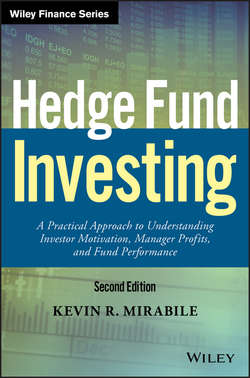Читать книгу Hedge Fund Investing - Mirabile Kevin R. - Страница 5
На сайте Литреса книга снята с продажи.
Preface
ОглавлениеThis book is designed to provide an overview of alternative investments and, in particular, instill in readers a working knowledge of that portion of alternative investments known as hedge fund investing.
The second edition of this book includes important updates related to industry flows and performance, plus new material covering the exciting new world of hedged mutual funds, secondary trading in hedge fund investments, and more information about the various techniques and instruments used by hedge fund managers to finance their portfolios.
The original motivation to write this book was to deliver a holistic view of hedge fund investing. That has not changed. The intention was to provide a cradle-to-grave perspective for first-time investors, for practitioners dealing with hedge funds as clients or counterparties, and for students wishing to learn how the sector operates from both a theoretical and a practical perspective. My personal experiences as a banker, accountant, service provider, investor, and partner in a hedge fund and a fund of hedge funds allows me to deliver some practical insights that I believe will facilitate learning.
The goal for this second edition is to once again present a comprehensive view of the reasons people invest in the sector, discuss how the managers, funds, and strategies interact, and recommend criteria people can use to select managers and funds – all without getting lost in too much detail. The approach is to cover a wide range of material in sufficient detail to familiarize readers with the issues, without getting lost in the multitude of regulations and mathematics needed to fully investigate any single topic. The hope is that by “keeping it simple” readers will learn enough about the asset class and the process of investing to give them confidence to move forward with asking the questions needed to become a great investor. Importantly, one of the goals for this book, if not its primary goal, is to make the asset class accessible and to demystify what is at times presented as an overly complex and esoteric category of investing. My approach is to deliver a balanced discussion of the broad spectrum of information needed to invest in hedge funds; however, it is inevitable that certain sections garner more emphasis than others.
The vast majority of information in this text comes from my personal experience in providing services to, trading with, lending to, or investing in hedge funds over the past 25 years. It also includes the advice and input of former colleagues and friends in the industry who share my interest in promoting educational efforts about hedge fund investing. It is only through education that the myths of hedge fund investing can be debunked and the opportunities can be assessed objectively. In this way, more people can reap the rewards and benefits of hedge fund investing while also fully understanding the risks of this exciting asset class.
The book is designed for those who have a basic knowledge of financial instruments, markets, asset allocation, and portfolio management. A rudimentary knowledge of statistics and some of the basic principles of calculus is also helpful, although not a requirement.
The book is organized into three parts related to basic concepts and market characteristics, an explanation of the individual strategies and financing tools used by hedge fund managers, and an overview of the process needed for the evaluation and analysis of individual managers and funds, including approaches to performing a due diligence process on any one fund. Each chapter has its own individual objectives and illustrations that can be read on their own or as part of the complete text.
Part One of the book provides readers with an overview of alternative investments. It highlights the similarities and differences among various types of alternatives, including hedge funds. It establishes the framework for understanding fund-level profit or loss calculations, performance measurement, and risk. It also provides readers with an understanding of the rationale for investing in hedge funds as well as the flows experienced by the sector over time.
Part Two is designed to explore several of the most prominent hedge fund investing strategies in more detail. It provides straightforward explanations of the important terms, definitions, trades, organization structures, portfolio constructions, performance measurements, and risk assessments used in each strategy. Strategies are organized into those that are not directly correlated to the traditional stock and bond market, those that are equity or fixed-income oriented, and those that are multistrategy in nature. It also includes new sections on the financing market and the secondary market for trading in hedge fund investments.
Part Three explores the nature of absolute, relative, and risk-adjusted performance measures; the impact of fund characteristics related to compensation arrangements; fund terms; and environmental conditions that motivate behavior and influence performance. This section also covers the due diligence process for selecting a single hedge fund for investment from a universe of peers. Topics covered include how to quickly assess and evaluate the people, pedigree, and processes that establish the DNA of any fund; understanding the investment and risk management process of a fund; the impact of the fund’s business model and counterparty risk on the fund’s performance and sustainability; and the role of a fund’s service providers in creating opportunities for a fund, influencing a fund’s performance, or protecting investors from fraud, blowups, or other calamities.
The book ends with some final observations, a review of the challenges faced by the industry today, and the outlook or trends that are likely to continue going forward.
This book can be used by commercial practitioners on a stand-alone basis or by educators in conjunction with supplemental material available online that includes PowerPoint slides, Excel spreadsheets, end-of-chapter discussion questions, and a test bank of over 100 questions. Educators can download the test bank and other learning tools at Wiley’s Instructor Site.
